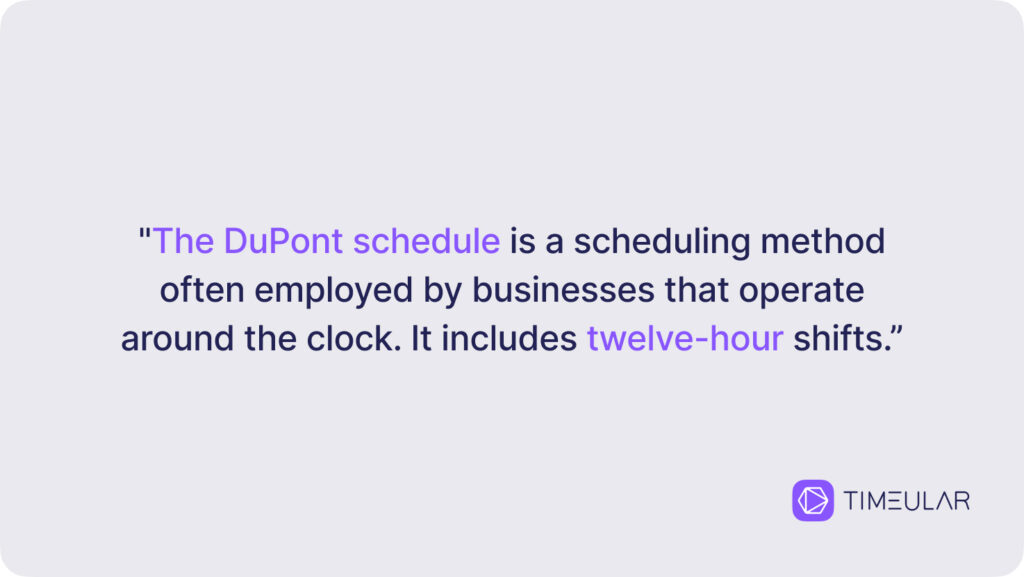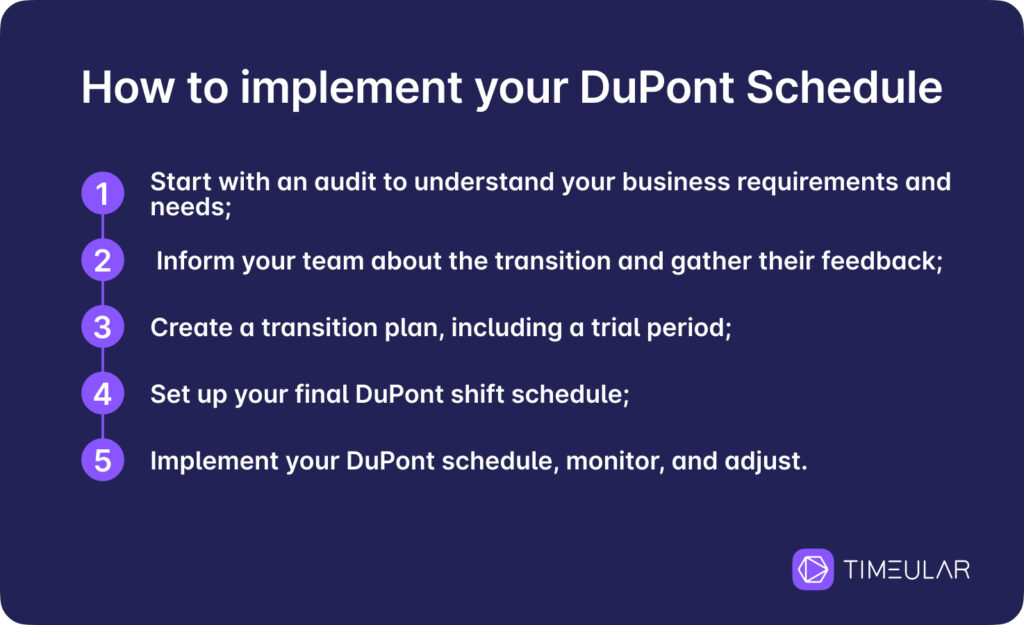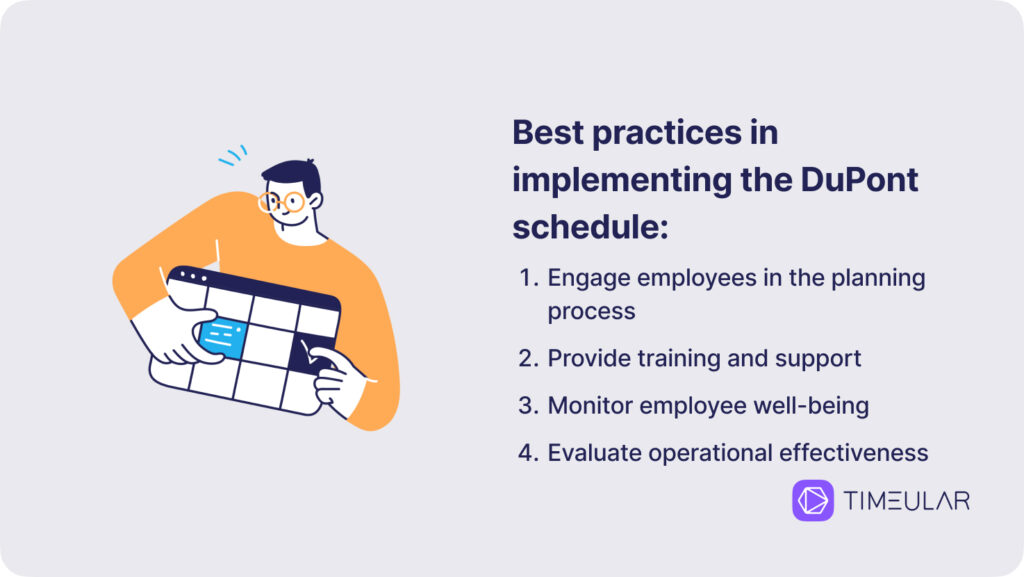O cronograma da DuPont: Prós, contras e etapas para implementá-lo
Are you struggling to maintain round-the-clock operations while keeping your employees happy and productive? Look no further than the DuPont schedule, the so-called shift schedule for businesses that never sleep.
In this guide, I’ll introduce you to this scheduling method, walking you through its history, model, and implementation.
You’ll discover:
What is the Dupont schedule?

The DuPont work schedule is a complex type of shift scheduling method often employed by businesses that operate around the clock. Examples of industries using the DuPont shift schedule are healthcare, police, food service, and manufacturing companies.
Also known as the 12-hour rotating shift schedule, this type of shift coverage provides 24/7 coverage for an organization. Each team works a 12-hour shift, with built-in breaks and days off, to alternate between day and night shifts.
Its purpose: It’s designed to ensure continuous operations, minimize the number of shift handovers, and provide employees with extended breaks between shifts for higher productivity and reduced burnout rates. An interesting benefit of the DuPont schedule for employees is that, in the fourth week, they have a full week off.
Here is a four-week cycle made on the DuPont schedule:
| Week | Mon. | Tue. | Wed. | Thu. | Fri. | Sat. | Sun. |
|---|---|---|---|---|---|---|---|
| 1 | Team A🌙 | Team A🌙 | Team A🌙 | Team B🔆 | Team B🔆 | Team B🔆 | Team A🌙 |
| 2 | Team C🌙 | Team C🌙 | Team C🌙 | Team C🌙 | Team D🔆 | Team D🔆 | Team B🔆 |
| 3 | Team D🛌 | Team D🛌 | Team A🔆 | Team A🔆 | Team A🔆 | Team B🌙 | Team D🔆 |
| 4 | Team B🌙 | Team C🛌 | Team C🛌 | Team C🔆 | Team C🔆 | Team D🌙 | Team B🌙 |
Table legend:
🔆 = Day shift
🌙 = Night shift
🛌 = Rest day
Where does the Dupont work schedule come from?
The Dupont schedule was created in the 1950s by the DuPont chemical company in the United States.
The company was exploring ways to improve plant efficiency and reduce the number of errors caused by too many shift changes. After experimenting with various scheduling models, they settled for the 12-hour rotating shift schedule, as it provided 24/7 coverage with fewer handovers and longer breaks for employees.
As the schedule was successful, other industries requiring continuous operations soon adopted it, including healthcare, manufacturing, and emergency services.
Is the Dupont shift work schedule for your workforce?
Configuring Dupont shift schedules for your team doesn’t make sense if the nature of your business doesn’t require a constant presence. So, seriously consider some factors that would impact your business, such as labor costs and others.
So here are some elements to take into account when considering to implement such a schedule:
Your business needs 24/7 coverage: If continuous operations are a must for your business to run smoothly, then you should staff accordingly. In this case, make sure you reshape the work schedules and ensure that employees work twelve-hour shifts, including a night shift, for more consecutive days.
12-hour shift schedules are feasible: You need to make sure that your business supports such shifts and that local labor laws allow employees to work 12-hour shifts. Not only that, but it would be beneficial to ask employees’ opinions on handling a 12-hour shift coverage if they could take day and night shifts while also attending their personal appointments and continuing their lives unaffected.
Minimizing shift handovers is a priority: If your operations need fewer shift changes to reduce miscommunication and errors or to support continuous production operations, then this is a clear sign that the DuPont schedule’s two shifts per day should be the go-to.
You care for your employees’ work-life balance: If offering your team the chance to unwind with extended shifts is important, then rotating shift patterns help them with that. Offering the chance to recharge and come back to work more energized is equally important as having continuous operations and high profitability.

When your employees clock in and out, Timeular fills out their timesheets automatically.
Common industries using the DuPont schedule
Checking which other industries apply the DuPont schedule can be a good indicator of whether it suits your business or not. Dive into the industries already using the Dupont shift schedule:
Manufacturing: Many manufacturing plants, particularly those in the chemical, petrochemical, and pharmaceutical sectors, use the DuPont shift schedule. They rely on DuPont shift schedules as they can maintain round-the-clock production while managing workload and employee safety.
Healthcare: It’s quite obvious that medical systems must function on continuous operations with day and night shifts. Therefore, hospitals, nursing homes, and other healthcare facilities often use the DuPont schedule to cover continuous patient care and accommodate the needs of their medical staff.
Energy and utilities: Power plants, oil and gas refineries, gas stations, and other energy and utility companies often implement the DuPont schedule, as they need to maintain constant operations.
Emergency services: Fire departments, police stations, and ambulance services must also be available on 24/7 shift coverage. In these types of services, distributing the workload evenly in 12-hour shifts in a rotating shift pattern is critical for managing vital emergencies with speed and mental sharpness.
Transportation and logistics: Some transportation and logistics companies, such as those involved in air traffic control, railway operations, or shipping and receiving, also adopt the DuPont shift schedule to maintain continuous service.
TIP: Consider implementing the 2 2 3 schedule, too, if the DuPont schedule might not suit your industry or team.
Advantages and disadvantages of the DuPont schedule
Before jumping into implementing the Dupont schedule, you should be aware of the advantages and disadvantages of the Dupont shift schedule.
As positive and beneficial as it may sound for your business to have consecutive twelve-hour shifts and cover its demand, you need to keep in mind several factors. The 12-hour shifts come with the following advantages:
24/7 coverage: Just as mentioned above, your operations might need to function uninterrupted without any downtime for 24 hours. Hence, by employing four teams and rotating 12-hour shifts, you’re ensuring that there is always a team available to handle production, customer service, or emergency responses, depending on your specific needs.
Fewer shift handovers: With only two shifts per day, the DuPont shift schedule reduces the number of shift handovers compared to the traditional 8-hour shift schedules. With fewer handovers, you can reduce the likelihood of miscommunication, errors, or delays that can occur when transitioning between shifts. The above also indirectly leads to better work efficiency.
Longer recovery time for employees: As the DuPont shift schedule includes a four-week cycle with a series of shifts (e.g., four-night shifts followed by three-day shifts), employees typically have several consecutive days off before starting their next block. These longer breaks allow them to fully rest, recover, and organize their personal appointments and lives and have a better work-life balance with a reduced risk of fatigue.
However, you need to also check the disadvantages:
Difficult shift schedule for some people: 12-hour shifts can be physically and mentally demanding for some employees. Working consecutive twelve-hour shifts for a couple of days can feel like a struggle, and you need to make sure you understand from the beginning the impact of such longer shifts on your teams. With the transition between day and night shifts, the Dupont schedule can be challenging for shift workers and disrupt sleep patterns.
Higher health and safety risks: Longer shifts increase health and safety risks for employees, as they may get tired during extended work hours. Regardless of their training level, fatigue can come up more than in eight-hour shifts, particularly in chemical or machinery manufacturing. Make sure you’re always aware of the overtime hours your employees work, and diligently calculate work hours to keep them accountable of not overworking.

When your employees clock in and out, Timeular fills out their timesheets automatically.
With the above in mind, if you’re considering configuring a DuPont schedule for your team, weigh these pros and cons and their impact on your business and team. If you’re implementing the DuPont schedule for the first time, take all the measures to offer support, precautions, and training to help your team adapt to it.
How to implement your DuPont schedule

1. Start with a needs audit
Know your business requirements: Identify if the DuPont schedule suits your operational needs, and make sure you identify peak operating hours and demands that require continuous coverage.
Audit your current workforce: Analyze your current staffing levels and availability. Identify if there are any gaps in the coverage, if tickets are surfacing, and if there are customer complaints about resource allocation and lack of agents available.
Make sure you have enough employees for the entire week to fill the shift schedule without causing fatigue or overtime hours. These questions might help in this process:
Is the timesheet app reflecting too many overtime hours, and are regular business hours no longer the norm in our business?
Do we have an abnormal amount of overtime pay?
How can I make sure that the workload is evenly distributed among my team members?
2. Inform your team and gather feedback
Educate employees: Explain the benefits and structure of the DuPont schedule while offering details on how the shifts work and how it will impact their work and personal lives.
Gather their feedback: Implementing the 12-hour shifts without your team’s feedback puts you at risk of disrespecting the new schedule and not adopting it. So, discuss with employees to understand their concerns and preferences. Address any issues and incorporate their feedback into the plan.
3. Plan the transition
Create a transition plan that outlines in detail all steps for transitioning to the new schedule. Remember that all changes in an organization need to be handled thoughtfully and with good care. Make sure you include timelines, training sessions, and trial periods in your plan.
Set a trial period: Establish a trial period to test how the DuPont shift schedule impacts effectiveness and motivation and survey employees to understand necessary adjustments.
The trial version can be created as an MVP, so as close to the final version as possible, or just at a smaller scale. You can make a schedule that rotates the teams through a sequence of day and night shifts, followed by days off. A common rotation pattern is:
Week 1: 4-night shifts (6 PM to 6 AM)
Week 2: 3 days off
Week 3: 3-day shifts (6 AM to 6 PM)
Week 4: 1 day off
Week 5: 3-night shifts
Week 6: 3 days off
Week 7: 4-day shifts
Week 8: 7 days off
A smaller-scale version that you can implement is the Panama schedule, also called the 2-2-3 shift schedule. The Panama schedule includes 12 hours in a cycle of 2 days on, 2 days off, and 3 days on, which repeats every two weeks.
4. Set up your final DuPont shift schedule
Create your teams: Divide your workforce into four teams, as the DuPont schedule requires teams to be split into four. This way, you obtain a balanced distribution of skills and experience.
Assign shifts: Allocate your workforce to the rotating schedule, and make sure each team understands their rotation and responsibilities. All employees should understand the schedule, their assignments, and any rules or guidelines related to shift swaps or time-off requests.
5. Implement and monitor
Put the DuPont schedule into action and closely monitor its effectiveness. Be prepared to make adjustments as needed based on employee feedback and operational requirements.

Best practices for implementing the DuPont schedule
Engage employees in the planning process: Involve your workforce in the development and deployment of the DuPont schedule to foster buy-in and address concerns.
Provide training and support: Offer training to help employees adapt to the new schedule and provide ongoing support to ensure a smooth transition.
Monitor employee well-being: Regularly check in with employees to assess the impact of the schedule on their health, safety, and work-life balance. Constantly adjust the schedule and process around it – no process is ever perfect.
Evaluate operational effectiveness: Assess the impact of the DuPont schedule on productivity, quality, and other key performance indicators. Use this data to make informed decisions about the schedule’s long-term viability.
Conclusão
The DuPont shift work schedule is a handy tool for organizations that need to operate on a 24/7 schedule. While it may not be suitable for every organization, the DuPont schedule is versatile and suits many companies across various industries.
However, evaluate carefully your organization’s needs and plan thoroughly before applying it to your schedules if you’re applying it for the first time. You may discover that going from the regular eight hours to three consecutive night shifts is a challenging stretch for your employees.
FAQS:
Can the DuPont shift schedule be applied to industries other than healthcare, manufacturing, and emergency services?
Yes, the DuPont shift schedule can be applied to various industries beyond healthcare, manufacturing, and emergency services. Any industry that requires continuous operation or 24/7 coverage can potentially benefit from implementing the DuPont schedule. For example, customer service is needed uninterruptedly in many businesses; therefore, it can be applied to many industries.
Is there a schedule that can be implemented only when upon request?
Yes, there is, and it’s called an “on-call” schedule. It is often implemented in healthcare, emergency services, or online stores, but only upon request. However, employees need to always be prepared to jump to work whenever they receive an alarm or a call. It is a schedule that requires more unpredictability to employees. However, if your business requires such immediate responses, it might be the right work for your business.
Are there any legal considerations when implementing the DuPont shift schedule?
Yes, businesses must ensure that their DuPont schedule complies with local labor laws and regulations. This may include elements such as maximum shift lengths, overtime pay, and mandatory breaks included in the schedule. Before implementing your own DuPont schedule, it’s recommended to consult with a legal expert who can help you respect compliance and avoid potential legal issues.